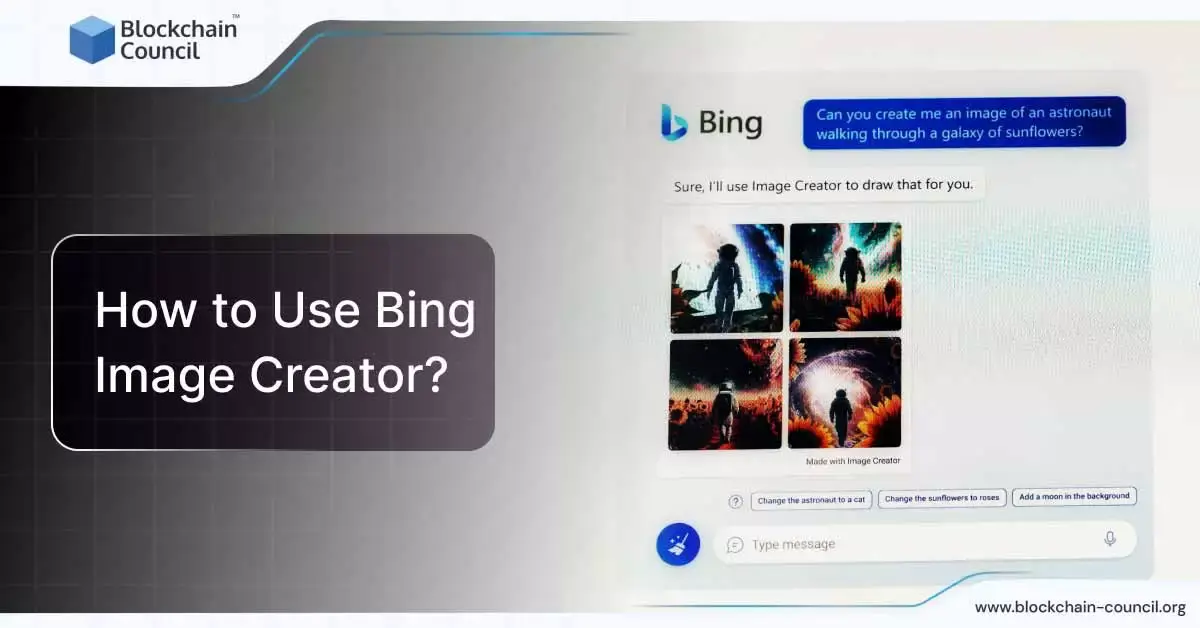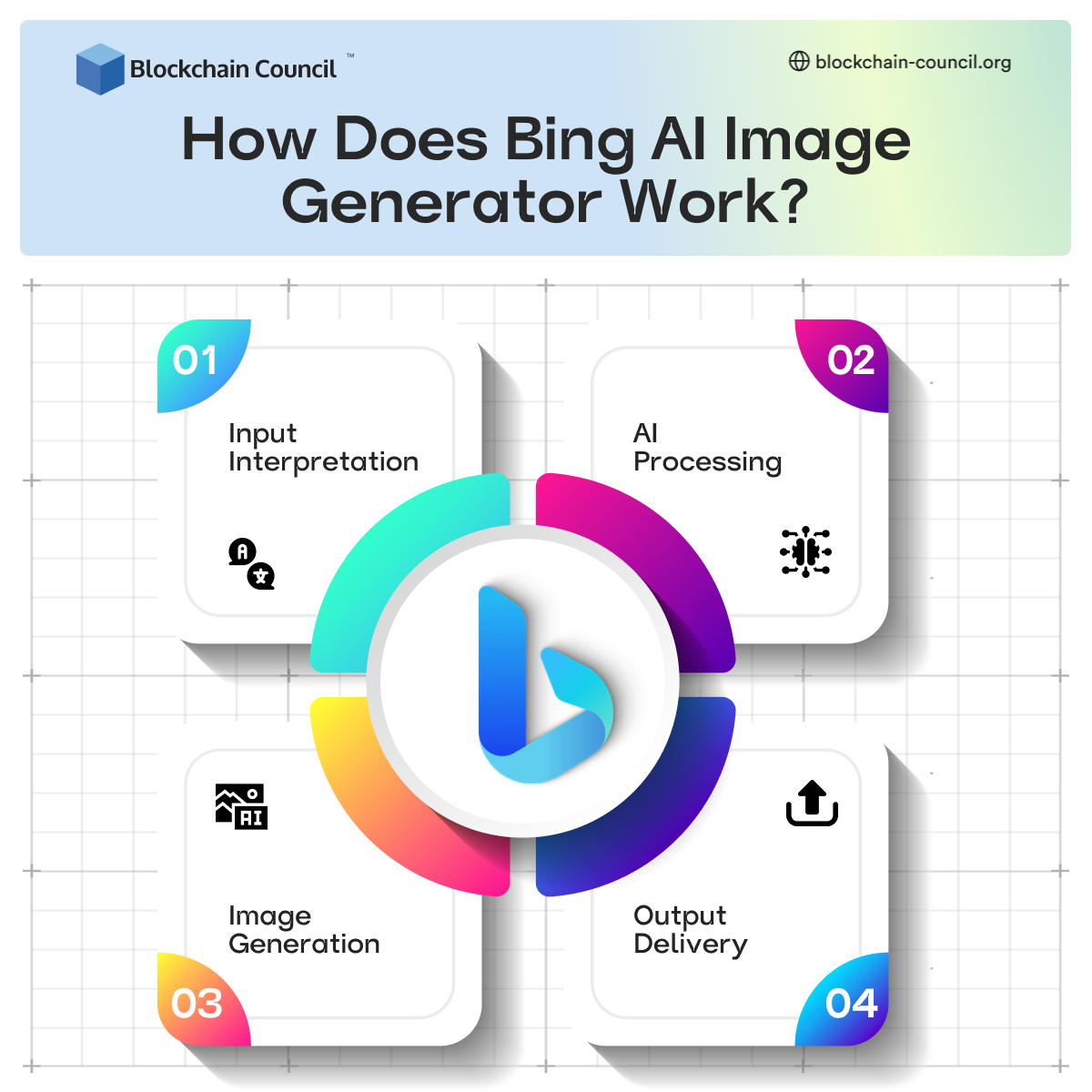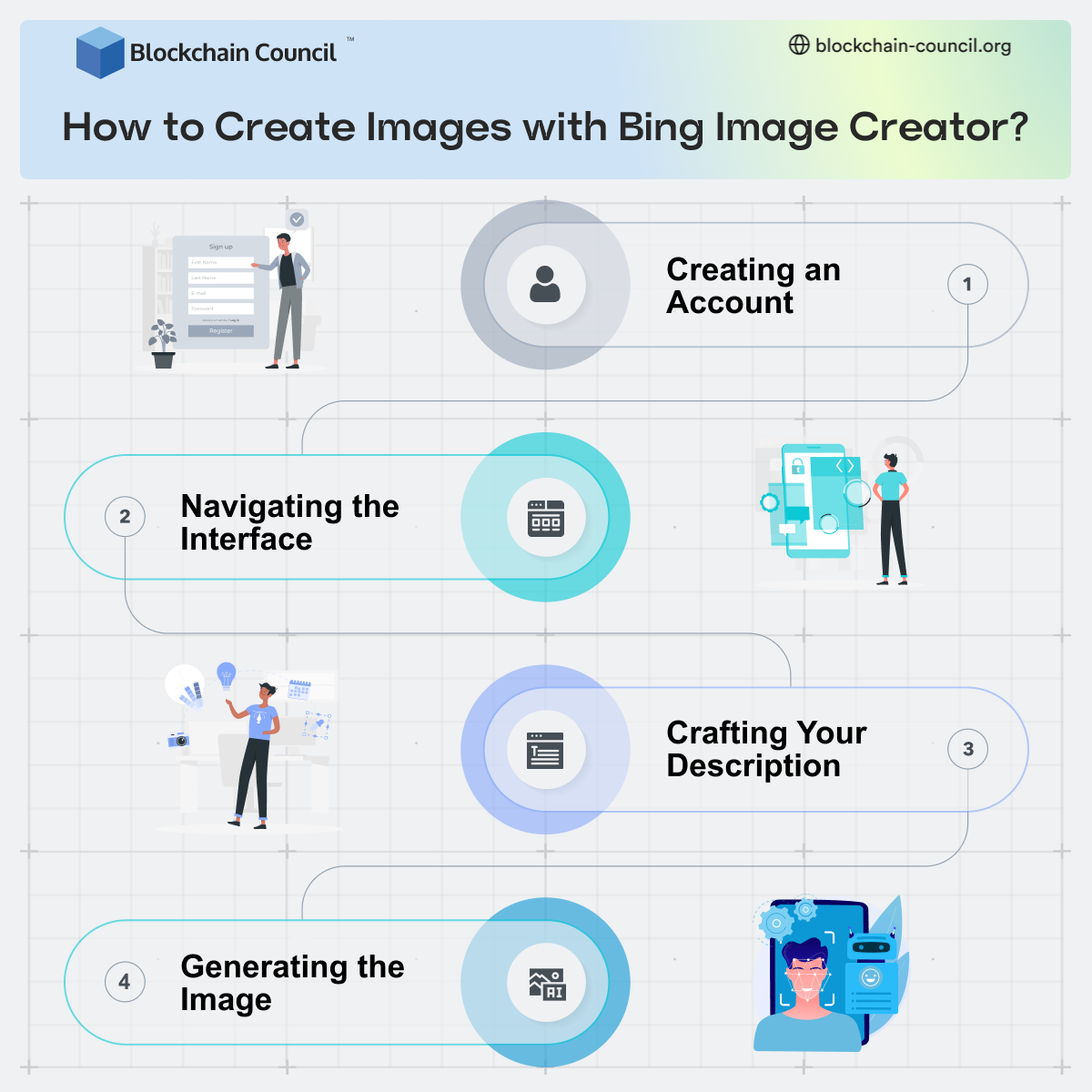
- Blockchain Council
- September 09, 2024
Bing Image Creator
Bing Image Creator or Bing AI Image Generator is an innovative tool launched by Bing. It incorporates cutting-edge AI technology to transform your words into vivid images. This platform enables users to describe the picture they envision using simple text, and the AI generates the corresponding image. Bing Image Creator marks a significant leap towards more interactive and creative web experiences, allowing users to generate written and visual content within a chat interface seamlessly.
How Does Bing AI Image Generator Work?
The Bing AI Image Generator operates on a sophisticated foundation provided by OpenAI’s DALL-E models, which are among the most advanced AI technologies for image creation. Here’s a simplified breakdown of its operation:
- Input Interpretation: When you enter a description of the image you want to create, Bing Image Creator interprets your words to understand the context, the elements you want included, and the overall mood or theme of the picture.
- AI Processing: Leveraging the power of DALL·E, the tool then processes this input, drawing from an extensive database of images and learned patterns of how objects, environments, and themes visually interact with each other.
- Image Generation: The AI synthesizes a new image based on the input description. This involves complex computations and creativity algorithms to ensure the output is both relevant to the description and visually coherent.
- Output Delivery: The generated image is then presented to the user. This whole process happens in a matter of seconds, showcasing the efficiency and power of Bing’s AI capabilities.
Bing Image Creator’s integration into the new Bing and Edge preview is part of a broader effort to make the web more visual and interactive. Beyond image creation, Bing has introduced AI-powered visual stories and updated Knowledge Cards, offering users a more engaging way to search and interact with content. This suite of features represents Bing’s commitment to delivering immersive experiences that make finding answers and exploring the web more interesting, useful, and fun.
How to Get Started with Bing Image Creator?
Bing Image Creator is a powerful tool that transforms your words into images. This advanced feature is part of the new AI-powered Bing and Microsoft Edge, offering a seamless integration for creating visual content. Whether you’re looking to generate unique images for a project, find inspiration, or simply explore your creativity, Bing Image Creator is your go-to solution.
To begin using Bing Image Creator, you have two main avenues: Bing Chat and Microsoft Edge. If you’re using Bing Chat, simply start a conversation and use prompts like “draw an image” or “create an image” to describe what you envision. This tool is initially available in Creative mode, catering to those looking to push the boundaries of their imagination.
For Microsoft Edge users, the process is equally straightforward. Bing Image Creator is integrated directly into the browser. Look for the Bing Image Creator icon in the sidebar or invoke it from Bing chat within Edge. This makes Edge the first and only browser with an AI-powered image generator built-in, streamlining your creative process without needing to switch between tools.
Also Read: How to Learn AI with GitHub Copilot?
Choosing the Right Conversation Style
Bing Image Creator offers different conversation styles to cater to various needs and preferences: Creative, Balanced, and Precise. Each style influences how your input is interpreted and the resulting images generated, making it crucial to choose the one that best fits your objective.
- Creative Mode is designed for those looking to explore their imagination without limits. It’s ideal for generating unique, inventive visuals that might not exist anywhere else. This mode is perfect for artistic projects, brainstorming sessions, or when you’re seeking inspiration for something truly out-of-the-box.
- Balanced Mode offers a middle ground, maintaining a blend of creativity and realism. It’s suitable for everyday use, where you need imaginative results that still adhere to a certain level of practicality and feasibility.
- Precise Mode, expected to be integrated soon, will cater to users seeking highly accurate and specific images based on their descriptions. This mode will be invaluable for tasks requiring detailed and exact visual representations.
Choosing the right conversation style is crucial for getting the most out of Bing Image Creator. It shapes the tool’s approach to your requests, ensuring the generated images meet your expectations and needs. Whether you’re crafting visuals for a professional project, personal exploration, or anything in between, Bing Image Creator, combined with the right conversation style, offers a versatile and powerful platform to bring your vision to life.
Microsoft and OpenAI have infused Bing Image Creator with responsible AI principles, ensuring a safe and ethical use of this technology. By selecting the appropriate mode and adhering to these guidelines, users can explore their creativity responsibly, knowing that safeguards are in place to prevent the creation of harmful or unsafe images.
Step-by-Step Guide to Creating Images
Creating stunning visuals with Bing Image Creator is straightforward if you follow the following steps:
1. Creating an Account
To access Bing Image Creator, first, you need to sign in. This step is crucial as it unlocks all the features of Image Creator. If you’re using Microsoft Edge and already logged into your Microsoft account, you’ll be automatically signed in. Otherwise, you’ll be prompted to log in or create a new Microsoft account if you don’t have one. This ensures a personalized experience and saves your creation history for future reference.
2. Navigating the Interface
Upon accessing Bing Image Creator, you’ll find a user-friendly interface. The key area to focus on is the dialogue box where you input your image description. This box is where your creativity comes to life. If you’re unsure where to start, Bing provides a “Surprise me” option and an “Explore ideas” tab to spark your inspiration.
3. Crafting Your Description
The quality of your generated image heavily relies on how detailed and descriptive your prompts are. For the best results, include adjectives, specify styles (like digital art or photorealistic), or even mention a specific artist’s style you’re inspired by. This level of detail helps the AI understand your vision better. To refine your description, consider the scene, objects, and emotions you want to evoke. For instance, instead of “a dog,” describe “a fluffy, brown dog playing in a sunny, grassy field.” This clarity and specificity guide the AI more effectively.
4. Generating the Image
After crafting your description, submit it by clicking the “Create” button. The AI then processes your input to generate the image, a process that usually takes a few moments. During this time, you can explore other features or start thinking about potential edits. Once your image is generated, take a moment to evaluate it. If the outcome isn’t what you expected, consider revising your description for clarity or adding more details. Although Bing Image Creator doesn’t offer direct editing options, you can utilize Microsoft Designer for further customizations, such as adding text or adjusting the layout.
Also Read: Learning AI with Microsoft Copilot
Advanced Tips and Tricks for Bing Image Creator
For bloggers, marketers, and online store owners, automating the process of adding text to images can save considerable time and enhance consistency across all visuals. One practical approach involves leveraging APIs like Bannerbear, an automated image and video generation platform. This tool can dynamically add text to images based on predefined templates, making it ideal for creating blog headers, product images with descriptions, or promotional banners that require regular updates.
How to Implement?
- Choose an API Service: Begin with a service like Bannerbear that offers straightforward integration with Bing Image Creator outputs.
- Create Templates: Design templates in Bannerbear that align with your brand’s visual identity. You can specify where text should appear on images.
- Automate Text Overlay: Utilize the API to automatically fetch images created with Bing Image Creator and overlay them with text based on your content needs. This could be product names, blog post titles, or any promotional message.
- Deployment: Integrate this process into your content management workflow, ensuring that every image is automatically prepared for publication across your digital platforms.
Enhancing Image Creation with Specificity and Style
Being Specific and Including Style in Prompts
To achieve the best results from Bing Image Creator, specificity in your prompts is crucial. This means going beyond basic descriptions and incorporating style, mood, and context into your requests.
Incorporating Reference Images
Providing reference images can significantly improve the output quality. Bing Image Creator allows for a level of customization where specific visual references guide the AI, resulting in images that are more aligned with your vision.
How to Implement?
- Craft Detailed Prompts: When generating images, use detailed descriptions. For example, instead of “a dog,” specify “a golden retriever in a sunny park with autumn leaves.”
- Specify Style: Add style elements to your prompt, such as “watercolor effect” or “digital art style,” to guide the AI towards your desired aesthetic.
- Use Reference Images: Whenever possible, upload reference images that closely match the style or content you’re aiming for. This could be a mood board for a product campaign or style samples for a blog theme.
Conclusion
As we wrap up this comprehensive guide on “How to Use Bing Image Creator,” it’s clear that the possibilities are as limitless as your imagination. This powerful tool not only simplifies the process of creating unique and compelling images but also opens up new avenues for creativity and digital expression. By following the insights and strategies outlined in this article, you’re now equipped to leverage Bing Image Creator to its fullest, transforming your ideas into stunning visual realities. Remember, the key to mastering Bing Image Creator lies in experimentation and continuous learning. So, keep exploring, stay updated with the latest features, and most importantly, let your creativity flow. Bing Image Creator is more than just a tool; it’s a gateway to visualizing the future.
FAQ’s
What is Bing Image Creator?
- Bing Image Creator is an innovative tool powered by Open AI’s DALL-E 3.
- It transforms text descriptions into vivid images, seamlessly blending creativity and technology.
- Users can generate both written and visual content within a chat interface, making it easy to use.
How does Bing Image Creator work?
- Bing Image Creator interprets user-provided text descriptions to understand the context and desired elements.
- It processes this input using sophisticated AI models like OpenAI’s DALL-E.
- The AI synthesizes a new image based on the description, ensuring it’s visually coherent and relevant.
- The generated image is then presented to the user, showcasing the efficiency of Bing’s AI capabilities.
How can I get started with Bing Image Creator?
- Users can access Bing Image Creator through Bing Chat or Microsoft Edge.
- In Bing Chat, start a conversation and use prompts like “draw an image” to describe your vision.
- In Microsoft Edge, look for the Bing Image Creator icon in the sidebar or use Bing chat within Edge to access the tool.
- Choose from different conversation styles like Creative, Balanced, or Precise to tailor the output to your needs.
Are there any advanced tips for using Bing Image Creator?
- Yes, users can automate text overlay using APIs like Bannerbear for adding text to images.
- Being specific in prompts by including style elements and providing reference images can improve output quality.
- Users can also sign in to unlock all features, craft detailed descriptions, and experiment with different conversation styles.
- Bing Image Creator is continuously evolving, so staying updated with the latest features and experimenting with different approaches is recommended.







































































 Guides
Guides News
News Blockchain
Blockchain Cryptocurrency
& Digital Assets
Cryptocurrency
& Digital Assets Web3
Web3 Metaverse & NFTs
Metaverse & NFTs
